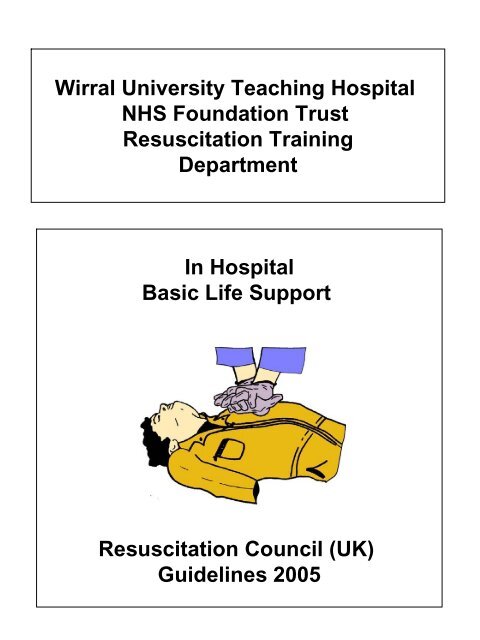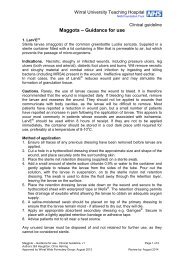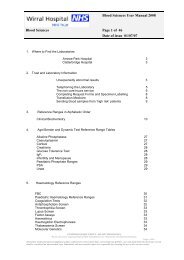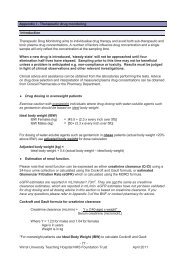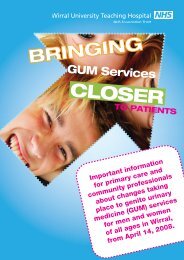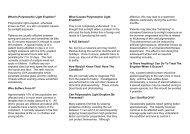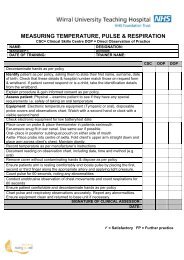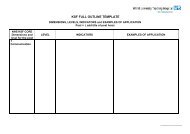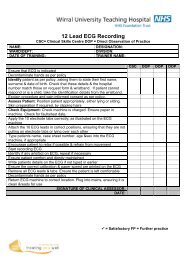Basic Life Support - Wirral University Teaching Hospital NHS ...
Basic Life Support - Wirral University Teaching Hospital NHS ...
Basic Life Support - Wirral University Teaching Hospital NHS ...
Create successful ePaper yourself
Turn your PDF publications into a flip-book with our unique Google optimized e-Paper software.
<strong>Basic</strong> <strong>Life</strong> <strong>Support</strong>Definition• The aim is to maintain anoxygen supply to the heart,brain & other vital organs tobuy time until the arrival ofthe Advanced <strong>Life</strong> <strong>Support</strong>Team
By following the chain of survival systematically you are doing all you can to aid thesurvival of the patient. This is a universal protocol that can be applied in & outside of thehospital. The first link is to:Call for HelpThe number for all UK emergency services is 999. Within <strong>Wirral</strong> <strong>Hospital</strong> <strong>NHS</strong> Trust(APH & CGH) the cardiac arrest number is 2222. On the St Catherine’s & VCH sites thenumber is (9) for an outside line then 999 for a paramedic ambulance crew as there isno cardiac arrest team on these sites. When a cardiac arrest call is put out it is ofvital importance that the hospital where the incident is taking place is stated togetherwith the department and exact location of the incident.<strong>Basic</strong> <strong>Life</strong> <strong>Support</strong> (BLS)BLS on its own is unlikely to reverse the cause of a cardiac arrest, however good qualityand effective BLS will buy valuable time whilst help is on route increasing the chances ofsurvival.
Early DefibrillationNot all cardiac arrest victims require defibrillation but of the ones that do it is from thisgroup of patients that the most survivors come from. For every minute a defibrillator isdelayed the prognosis is reduced by 7-10%Post Resuscitation CareThis is concerned with stabilisation of the patient by the use of invasive procedures,administration of drugs and transfer to specialised units for example Coronary Care,Intensive Care or High Dependency Unit.
Assess for DangerMake the area safe or remove thecasualty from dangerSafety AssessmentEach emergency scene should be assessed for danger. Remember the number one personis the rescuer(s). No accident or emergency justifies another one. Check for any possibledanger before the patient is assessed.Danger Outside of the <strong>Hospital</strong>• Traffic•Fire• Electricity•Gas• Falling Masonry• Water etc...Dangers in <strong>Hospital</strong>• Manual Handling Problems i.e. Collapses in baths• Body Fluids• Wet Floors & Environments
Check for a Response& Start Shouting for HelpCasualty AssessmentCheck the casualty’s level ofconsciousness by gentlyshaking their shoulders andshouting at the person“Can you hear me, openyour eyes”
Upon Finding a Collapsed,Unresponsive PatientStart Shouting For Help & IfAvailable Pull theEmergency Call AlarmWhen finding a collapsed, unresponsivepatient it is obvious that you will requireassistance as soon as possible. Startshouting for help immediately eventhough you have not made a fullassessment of the victim yet.
No ResponseOPEN THE AIRWAYA patient whose level ofconsciousness has diminishedwill be in danger of airwayobstruction. The main threat tothe patients airway is their owntongue falling to the back ofthe throat
OPEN THE AIRWAYHead Tilt/Chin Lift.The best and most effective way of opening theairway is with the head tilt chin lift manoeuvre.This lifts the tongue & straightens out the airway.However, If cervical spine injury is suspectedthe jaw thrust method should be used(see next page).Once the airway has been opened a checkshould be made for obstruction due to foreignmaterial. If foreign material is present a fingersweep, magils forceps or suction may beindicated to remove the fluid/object.If the patient has dentures in place and they arewell fitting leave them in as they will support theface making ventilation’s simpler to perform.If dentures are loose or ill fitting they will have tobe removed
OPEN THE AIRWAYJaw ThrustIf a cervical spine injury is suspectedthe jaw thrust manoeuvre should beused to open the airway.It must be remembered that if the jawthrust method is proving ineffectivethe rescuer may have to revert back toa small amount of head tilt chin liftas the airway always takes priority.
Check Breathing& Carotid Pulse (if trained)for no more than 10 secondsLook, Listen & Feel for 10 secondsLook- for chest movementListen- for breath soundsFeel- for expired air on the side of faceOnly check for a central pulse ifexperienced & trained in this technique3 choices of how to assess for a cardiac arrest•Check only breathing for 10 seconds• Check breathing & carotid pulse simultaneouslyfor no more than 10 seconds• Independently check breathing for 10 secondsand then immediately check carotid pulse for10 seconds.It is important that in a patient who is onlymaking agonal gasps that CPR must becommenced immediately as this is an early sign ofa cardiac arrest. If there is any doubt that a patientis breathing or has a pulse (if performed) thencommence CPR- DO NOT check for longer than10 seconds
Unresponsive & BreathingPatient Put them in to theRecovery PositionNot in a Clinical AreaPut an unconscious but breathing casualty in to therecovery position. There are many methods forputting people in to the recovery position. Themost important thing to remember is to turn thecasualty on to their side by the method that youknow best.The priority of the recovery position is to maintainthe airway (head tilt chin lift) when the patient is ontheir side. This will ensure the tongue is removedfrom the back of the throat and will allow anysecretions &/or vomit to drain from the mouthreducing the risk of aspiration.Continue to monitor the patient closely as they mayneed to be turned on to their back and requireresuscitative procedures at anytime.
Responsive/UnresponsiveBreathing PatientIn The Clinical AreaCall the appropriate medical team/outreach team.Assess the patient:•A B C D E•Give high flow O2•Attach monitor/defib•Gain I.V. Access•Commence appropriate treatment•Hand over to team
No Breathing & No Pulse (if performed)2222Send colleagues for the cardiacarrest team & to collect & returnwith the emergency equipmentIf still alone GO FOR HELPyourself and collect theemergency equipmentIn the majority of cases when faced with anunresponsive none breathing adult casualty thecause of the collapse is probably cardiac in nature.The quicker help and a defibrillator is obtained thebetter the prognosis.REMEMBER DO NOT START RESUSCITATIONIF ALONE YOU MUST GET OR GO FOR HELP
Start CPRStart with 30 chestcompressionsExpose the chest area to skin level. The rescuer shouldput the heel of one hand in the middle of the lower half ofthe sternum and place the other hand on top. They shouldpull the fingers back so only the heel of the hand is incontact with the centre of the breast bone as this is lesslikely to cause damage. Lean over the patient withshoulders above hands. Keep your arms straight andelbows locked. Press down vertically by 4-5 cms, keepingthe movements smooth. The rate of compressions is100 per minute. This is a rate which means nearly 2compressions a second
Continue CPRFollow the 30 chest compressionwith 2 ventilation’s.Pinch the patients nose, take a good breath, geta good seal around the patients mouth & blowsteadily.Each ventilation should only take 1 second tomake the chest rise and 1 second to watch itfall.Do not over ventilate as this increases thechance of the patient vomiting , regurgitating &aspirating.Following the 2 ventilation’s the rescuer shouldquickly return to chest compressions.The ratio for chest compressions & ventilation’sis:30:2
Continue Resuscitation30:2During BLS do not stop to recheck breathing/pulseunless the patient shows signs of life. The likely hoodof BLS reversing the cause of a cardiac arrest isunlikely. Consequently, rechecking for signs of lifeinterrupts CPR which is oxygenation for the patient.
When EmergencyEquipment Arrives:Continue CPR&Set Up EquipmentIf Trained CommenceImmediate <strong>Life</strong> <strong>Support</strong>/Advanced <strong>Life</strong> <strong>Support</strong>
Notes:Chest Compression Only CPRA significant number of professionals (& lay rescuers) are reluctant to perform mouthto mouth resuscitation. If a rescuer is reluctant to perform mouth to mouth ventilationcompression only CPR can be provided whilst the emergency equipment is on route.Combined with the head tilt chin lift to provide a patent airway, chest compressionsalone may provide some ventilation of the patients lungs whilst equipment is set up.Respiratory ArrestIn a non breathing patient if a carotid pulse and other signs of life have been detectedthe rescuer should now follow the respiratory arrest protocol.This is to continue ventilating the patient and rechecking for a carotid pulse &/or signsof life every 10 breaths/ventilation’s.Remember the patient may start to breath or a respiratory arrest may progress to acardiac arrest and full CPR will need to be commenced.
In <strong>Hospital</strong> <strong>Basic</strong> <strong>Life</strong> <strong>Support</strong>Safe ApproachCheck ResponseShout for HelpOpen AirwayNot breathing, pulsepresentVentilate & recheckcirculation every 10 breathsCheck Breathing(& if trained pulse)Breathingput in recovery position/or assess A,B,C,D,E& commence appropriatetreatmentCommence CPR30:2Commence ILS/ALS
Reference ListResuscitation Council (UK) (2005), ResuscitationGuidelines 2005, Adult <strong>Basic</strong> <strong>Life</strong> <strong>Support</strong>, London,Resuscitation Council (UK), 9-20AcknowledgementsWith grateful thanks to Dave Olley for the use of theimages from the CD Rom First Aid ImagesNote:CPR Training is mandatory every 12 months for the majority of staff withdirect patient contact.The Resuscitation Training Department would like to inform staff that if theyrequire extra training or advice outside of this 12 month period on airwayequipment, defibrillators or pre Advanced <strong>Life</strong> <strong>Support</strong> Course sessions etc…we will be more than happy to arrange for you to come and see us.You can do this by contacting a Resuscitation Officer on ext 4480 or bleepLisa Delaney on 4480orSteve Bell on 4470


